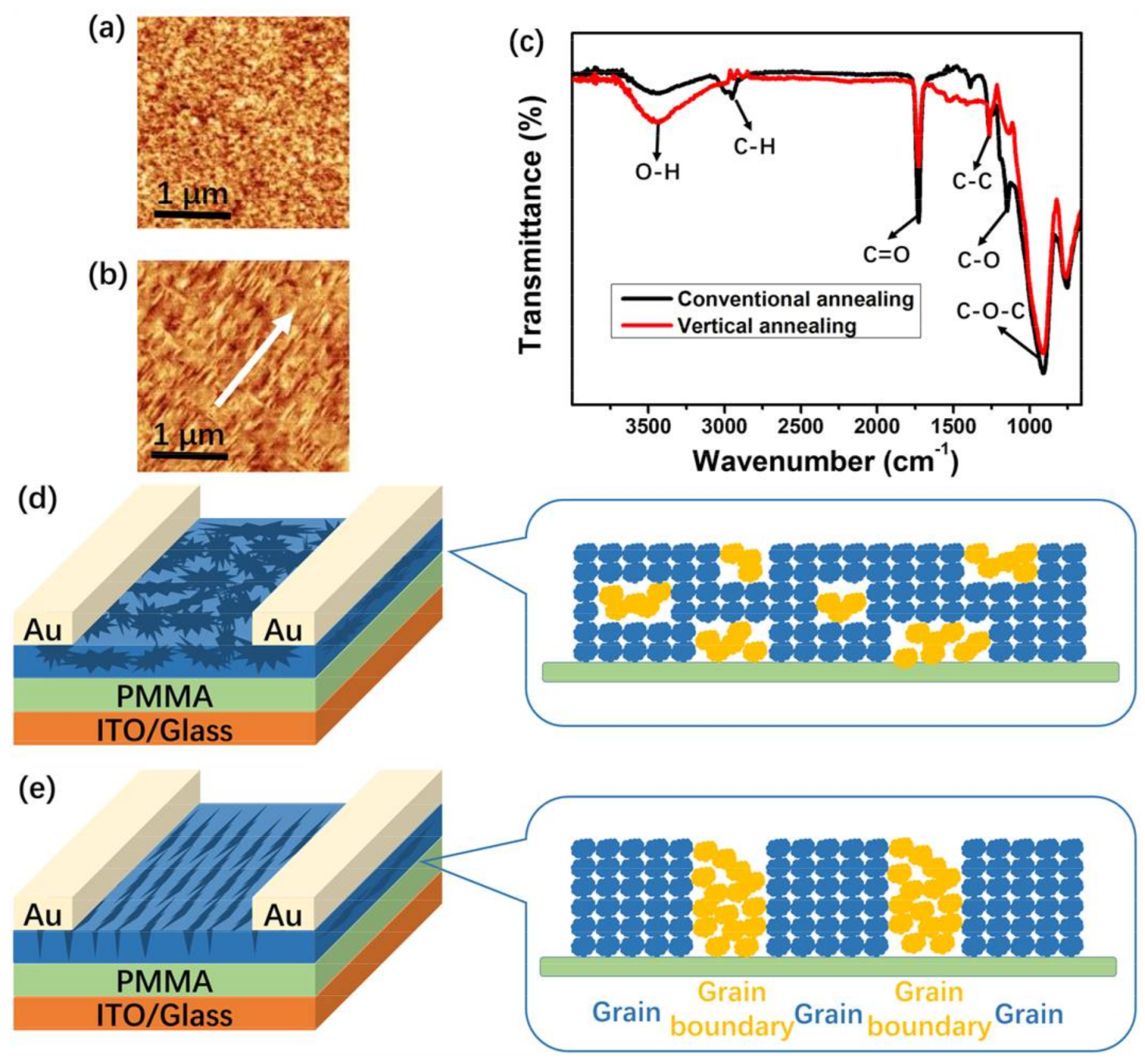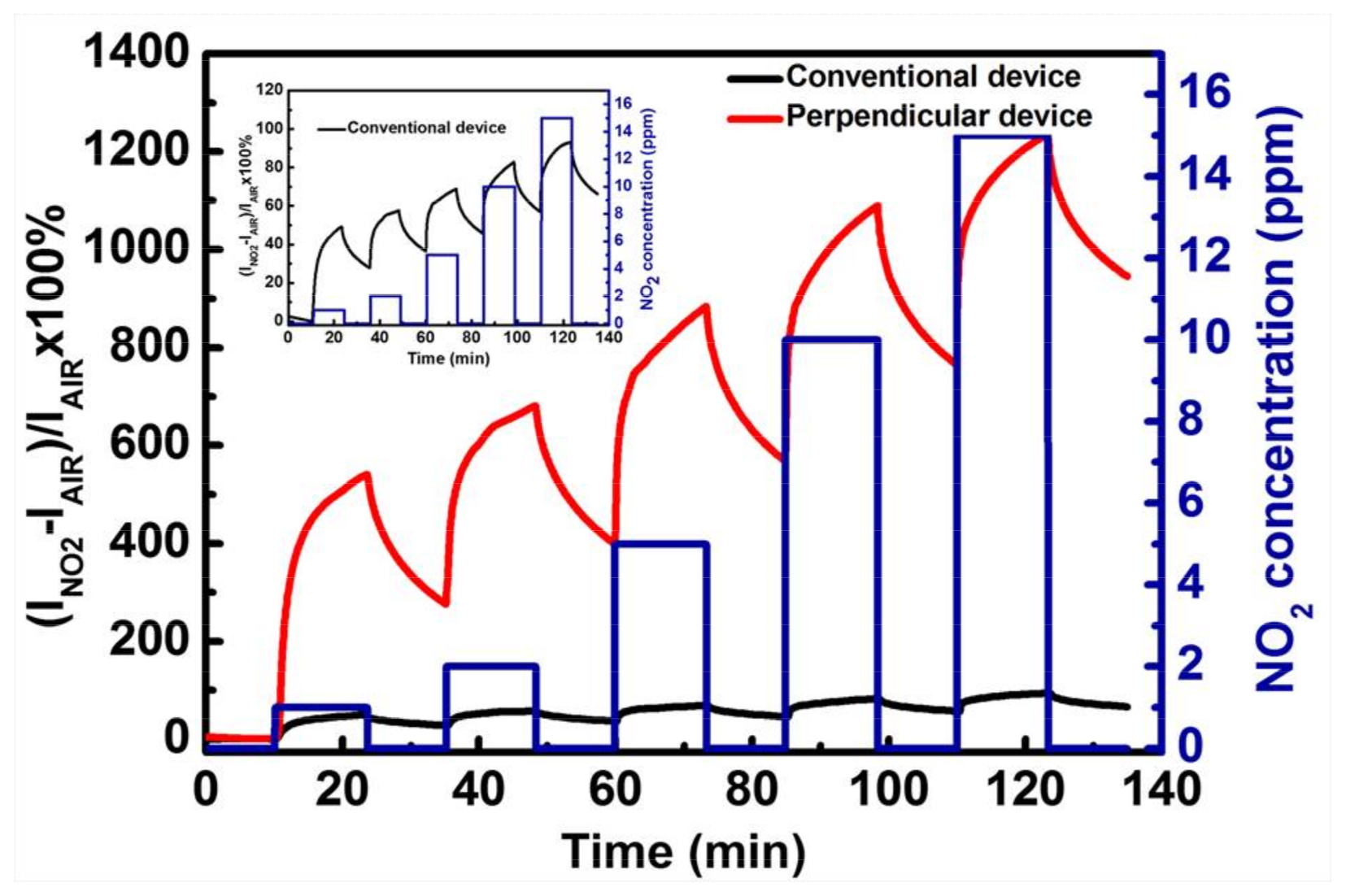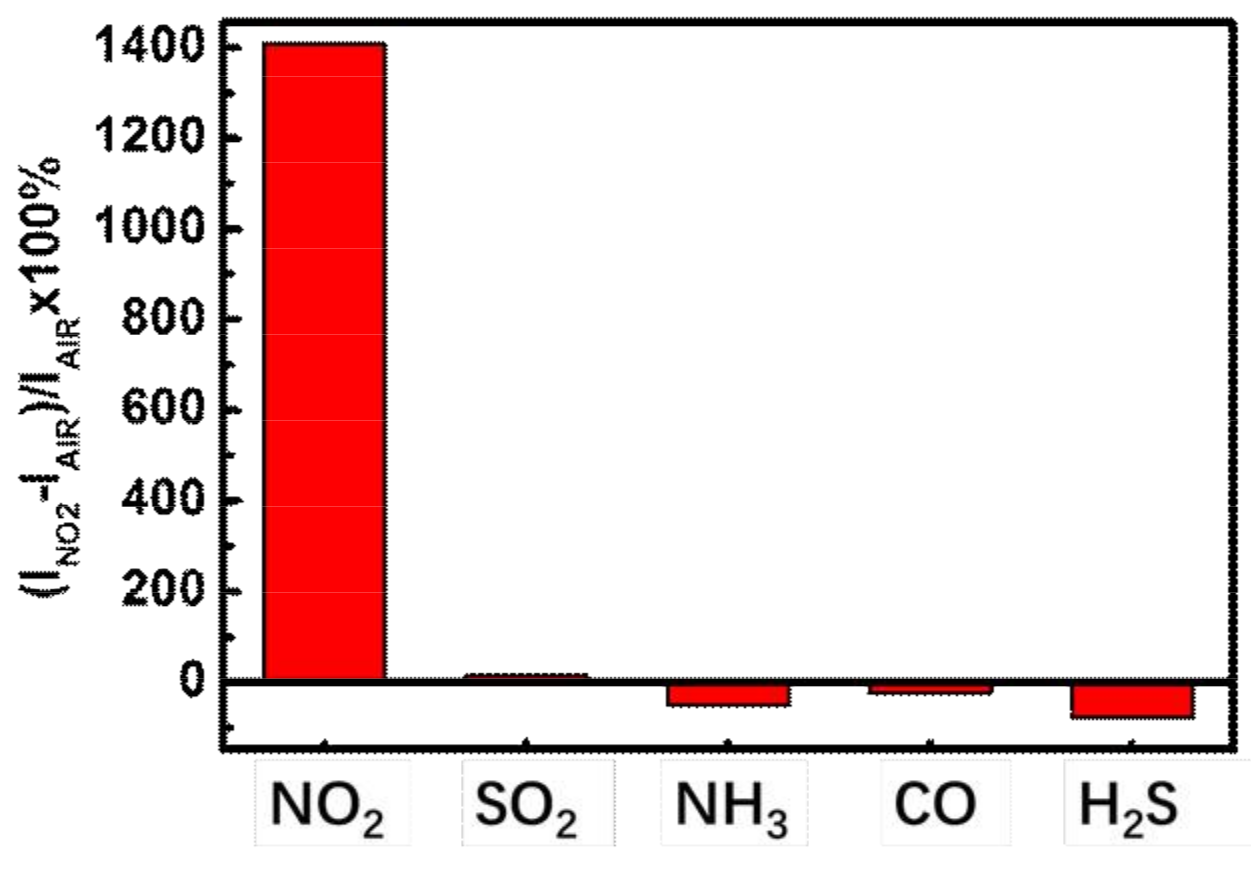Effect of Vertical Annealing on the Nitrogen Dioxide Response of Organic Thin Film Transistors
Abstract
1. Introduction
2. Experimental
2.1. Device Preparation
2.2. Film Characterization and Sensor Test
3. Results and Discussion
4. Conclusions
Supplementary Materials
Acknowledgments
Author Contributions
Conflicts of Interest
References
- Huang, W.; Zhuang, X.; Melkonyan, F.S.; Wang, B.; Zeng, L.; Wang, G.; Han, S.; Bedzyk, M.J.; Yu, J.; Marks, A.; et al. UV-Ozone interfacial modification in organic transistors for high-sensitivity NO2 detection. Adv. Mater. 2017, 29, 1701706. [Google Scholar] [CrossRef] [PubMed]
- Nejat, P.; Jomehzadeh, F.; Taheri, M.M.; Gohari, M.; Abd Majid, M.Z. A global review of energy consumption, CO2 emissions and policy in the residential sector (with an overview of the top ten CO2 emitting countries). Renew. Sustain. Energ. Rev. 2015, 43, 843–862. [Google Scholar] [CrossRef]
- Guo, Y.; Yu, G.; Liu, Y. Functional organic field-effect transistors. Adv. Mater. 2010, 22, 4427–4447. [Google Scholar] [CrossRef] [PubMed]
- Zang, Y.; Huang, D.; Di, C.A.; Zhu, D. Device engineered organic transistors for flexible sensing applications. Adv. Mater. 2016, 28, 4549–4555. [Google Scholar] [CrossRef]
- Qian, C.; Sun, J.; Kong, L.A.; Gou, G.; Zhu, M.; Yuan, Y.; Huang, H.; Gao, Y.; Yang, J. High-performance organic heterojunction phototransistors based on highly ordered copper phthalocyanine/para-sexiphenyl thin films. Adv. Funct. Mater. 2017, 27, 1604933. [Google Scholar] [CrossRef]
- Baeg, K.J.; Caironi, M.; Noh, Y.Y. Toward printed integrated circuits based on unipolar or ambipolar polymer semiconductors. Adv. Mater. 2013, 25, 4210–4244. [Google Scholar] [CrossRef] [PubMed]
- Wu, X.; Mao, S.; Chen, J.; Huang, J. Strategies for improving the performance of sensors based on organic field-effect transistors. Adv. Mater. 2018. [Google Scholar] [CrossRef] [PubMed]
- Hodgkinson, J.; Tatam, R.P. Optical gas sensing: A review. Meas. Sci. Technol. 2013, 24, 012004. [Google Scholar] [CrossRef]
- Huang, Z.F.; Song, J.; Pan, L.; Zhang, X.; Wang, L.; Zou, J.J. Tungsten oxides for photocatalysis, electrochemistry, and phototherapy. Adv. Mater. 2015, 27, 5309–5327. [Google Scholar] [CrossRef] [PubMed]
- Kumar, P.; Morawska, L.; Martani, C.; Biskos, G.; Neophytou, M.; Di Sabatino, S.; Bell, M.; Norford, L.; Britter, R. The rise of low-cost sensing for managing air pollution in cities. Environ. Int. 2015, 75, 199–205. [Google Scholar] [CrossRef] [PubMed]
- Smulko, J.M.; Trawka, M.; Granqvist, C.G.; Ionescu, R.; Annanouch, F.; Llobet, E.; Kish, L.B. New approaches for improving selectivity and sensitivity of resistive gas sensors: A review. Sensor Rev. 2015, 35, 340–347. [Google Scholar] [CrossRef]
- Trung, T.Q.; Tien, N.T.; Seol, Y.G.; Lee, N.E. Transparent and flexible organic field-effect transistor for multi-modal sensing. Org. Electron. 2012, 13, 533–540. [Google Scholar] [CrossRef]
- Han, S.; Zhuang, X.; Jiang, Y.; Yang, X.; Li, L.; Yu, J. Poly(vinyl alcohol) as a gas accumulation layer for an organic field-effect transistor ammonia sensor. Sens. Actuator B Chem. 2017, 243, 1248–1254. [Google Scholar] [CrossRef]
- Zhang, X.; Jie, J.; Deng, W.; Shang, Q.; Wang, J.; Wang, H.; Chen, X.; Zhang, X. Alignment and patterning of ordered small-molecule organic semiconductor micro-/nanocrystals for device applications. Adv. Mater. 2016, 28, 2475–2503. [Google Scholar] [CrossRef] [PubMed]
- Wang, B.; Zhu, T.; Huang, L.; Tam, T.L.D.; Cui, Z.; Ding, J.; Chi, L. Addressable growth of oriented organic semiconductor ultra-thin films on hydrophobic surface by direct dip-coating. Org. Electron. 2015, 24, 170–175. [Google Scholar] [CrossRef]
- Su, Y.; Gao, X.; Liu, J.; Xing, R.; Han, Y. Uniaxial alignment of triisopropylsilylethynyl pentacene via zone-casting technique. Phys. Chem. Chem. Phys. 2013, 15, 14396–14404. [Google Scholar] [CrossRef] [PubMed]
- Van Tho, L.; Park, W.T.; Choi, E.Y.; Noh, Y.Y. Highly aligned conjugated polymer films prepared by rotation coating for high-performance organic field-effect transistors. Appl. Phys. Lett. 2017, 110, 163303. [Google Scholar] [CrossRef]
- Nam, S.; Jeong, Y.J.; Jung, J.; Kim, S.H.; Ahn, J.; Shin, K.; Jang, J. Direct printing of soluble acene crystal stripes by a programmed dip-coating process for organic field-effect transistor applications. J. Mater. Chem. C 2018, 6, 799–807. [Google Scholar] [CrossRef]
- Niazi, M.R.; Li, R.; Qiang Li, E.; Kirmani, A.R.; Abdelsamie, M.; Wang, Q.; Pan, W.; Payne, M.M.; Anthony, J.E.; Smilgies, D.M.; et al. Solution-printed organic semiconductor blends exhibiting transport properties on par with single crystals. Nat. Commun. 2015, 6, 8598–8607. [Google Scholar] [CrossRef] [PubMed]
- Lin, F.J.; Guo, C.; Chuang, W.T.; Wang, C.L.; Wang, Q.; Liu, H.; Hsu, C.S.; Jiang, L. Directional solution coating by the chinese brush: A facile approach to improving molecular alignment for high-performance polymer TFTs. Adv. Mater. 2017, 29, 1606987. [Google Scholar] [CrossRef] [PubMed]
- Janneck, R.; Vercesi, F.; Heremans, P.; Genoe, J.; Rolin, C. Predictive model for the meniscus-guided coating of high-quality organic single-crystalline thin films. Adv. Mater. 2016, 28, 8007–8013. [Google Scholar] [CrossRef] [PubMed]
- Bharti, D.; Raghuwanshi, V.; Varun, I.; Mahato, A.K.; Tiwari, S.P. Directional solvent vapor annealing for crystal alignment in solution-processed organic semiconductors. ACS Appl. Mater. Interfaces 2017, 9, 26226–26233. [Google Scholar] [CrossRef] [PubMed]
- Keum, C.M.; Bae, J.H.; Kim, M.H.; Park, H.L.; Payne, M.M.; Anthony, J.E.; Lee, S.D. Topography-guided spreading and drying of 6,13-bis(triisopropylsilylethynyl)-pentacene solution on a polymer insulator for the field-effect mobility enhancement. Appl. Phys. Lett. 2013, 102, 193307. [Google Scholar] [CrossRef]
- Li, Y.; Ji, D.; Liu, J.; Yao, Y.; Fu, X.; Zhu, W.; Xu, C.; Dong, H.; Li, J.; Hu, W. Quick fabrication of large-area organic semiconductor single crystal arrays with a rapid annealing self-solution-shearing method. Sci. Rep. 2015, 5, 13195. [Google Scholar] [CrossRef] [PubMed]
- Li, L.; Gao, P.; Baumgarten, M.; Mullen, K.; Lu, N.; Fuchs, H.; Chi, L. High performance field-effect ammonia sensors based on a structured ultrathin organic semiconductor film. Adv. Mater. 2013, 25, 3419–3425. [Google Scholar] [CrossRef] [PubMed]
- Wang, B.; Ding, J.; Zhu, T.; Huang, W.; Cui, Z.; Chen, J.; Huang, L.; Chi, L. Fast patterning of oriented organic microstripes for field-effect ammonia gas sensors. Nanoscale 2016, 8, 3954–3961. [Google Scholar] [CrossRef] [PubMed]
- Shi, W.; Yu, X.; Zheng, Y.; Yu, J. DNA based chemical sensor for the detection of nitrogen dioxide enabled by organic field-effect transistor. Sens. Actuator B Chem. 2016, 222, 1003–1011. [Google Scholar] [CrossRef]
- Wang, Z.; Huang, L.; Zhu, X.; Zhou, X.; Chi, L. An ultrasensitive organic semiconductor NO2 sensor based on crystalline TIPS-pentacene films. Adv. Mater. 2017, 29, 1703192. [Google Scholar] [CrossRef] [PubMed]
- Hsu, M.H.; Chang, S.P.; Chang, S.J.; Wu, W.T.; Li, J.Y. Oxygen partial pressure impact on characteristics of indium titanium zinc oxide thin film transistor fabricated via RF sputtering. Nanomaterials 2017, 7, 156. [Google Scholar] [CrossRef] [PubMed]
- Zhuang, X.; Huang, W.; Yang, X.; Han, S.; Li, L.; Yu, J. Biocompatible/degradable silk fibroin:poly(vinyl alcohol)-blended dielectric layer towards high-performance organic field-effect transistor. Nanoscale Res. Lett. 2016, 11, 439–446. [Google Scholar] [CrossRef] [PubMed]
- Zhuang, X.; Huang, W.; Han, S.; Jiang, Y.; Zheng, H.; Yu, J. Interfacial modifying layer-driven high-performance organic thin-film transistors and their nitrogen dioxide gas sensors. Org. Electron. 2017, 49, 334–339. [Google Scholar] [CrossRef]
- Shi, W.; Zheng, Y.; Taylor, A.D.; Yu, J.; Katz, H.E. Increased mobility and on/off ratio in organic field-effect transistors using low-cost guanine-pentacene multilayers. Appl. Phys. Lett. 2017, 111, 043301. [Google Scholar] [CrossRef]
- Pitsalidis, C.; Kalfagiannis, N.; Hastas, N.A.; Karagiannidis, P.G.; Kapnopoulos, C.; Ioakeimidis, A.; Logothetidis, S. High performance transistors based on the controlled growth of triisopropylsilylethynyl-pentacene crystals via non-isotropic solvent evaporation. RSC Adv. 2014, 4, 20804–20813. [Google Scholar] [CrossRef]
- Andringa, A.M.; Christian Roelofs, W.S.; Sommer, M.; Thelakkat, M.; Kemerink, M.; de Leeuw, D.M. Localizing trapped charge carriers in NO2 sensors based on organic field-effect transistors. Appl. Phys. Lett. 2012, 101, 153302. [Google Scholar] [CrossRef]
- Wang, J.; Jiang, C. Electrical transport mechanism of single monolayer pentacene film employing field-effect characterization. Org. Electron. 2015, 16, 164–170. [Google Scholar] [CrossRef]
- Mirza, M.; Wang, J.; Wang, L.; He, J.; Jiang, C. Response enhancement mechanism of NO2 gas sensing in ultrathin pentacene field-effect transistors. Org. Electron. 2015, 24, 96–100. [Google Scholar] [CrossRef]
- Han, S.; Zhuang, X.; Shi, W.; Yang, X.; Li, L.; Yu, J. Poly(3-hexylthiophene)/polystyrene (P3HT/PS) blends based organic field-effect transistor ammonia gas sensor. Sens. Actuator B Chem. 2016, 225, 10–15. [Google Scholar] [CrossRef]






| Test Method | Sensitivity | Selectivity | Response Speed | Cost | Detection Range | Ref. |
|---|---|---|---|---|---|---|
| OTFTs | excellent | good | great | low | ppb | [4,5,6,7] |
| Infrared Absorption | great | good | good | common | wide | [8] |
| Photochemistry | great | great | great | common | ppm | [9] |
| Chromatography | excellent | excellent | excellent | expensive | ppm | [10] |
| Resistive | excellent | good | good | low | ppm | [11] |
| Author | Technique | Semiconductor | Solvent | Mobility (cm2 V−1 s−1) | Ref. |
|---|---|---|---|---|---|
| Su | Zone casting | TIPS-pentacene | Chloroform | 0.67 | [16] |
| Van Tho | Rotation coating | DPPT-TT | DCB | 1.95 | [17] |
| Nam | Dip coating | TIPS-pentacene | DCM | 0.24 | [18] |
| Niazi | Blade coating | diF-TES-ADT | toluene | 6.70 | [19] |
| Lin | Brush coating | DPPDTT | DCB | 11.20 | [20] |
| Janneck | Meniscus-guided coating | C8-BTBT | heptane | 7.00 | [21] |
| Device | µ (cm2/Vs) | Ion/Ioff | VT (V) | SS (V/dec) |
|---|---|---|---|---|
| Conventional device | 0.0186 | ~104 | −2.4 | 2.0 |
| Parallel device | 0.0275 | ~104 | −2.0 | 1.8 |
| Perpendicular device | 0.0092 | ~103 | −20.0 | 6.8 |
© 2018 by the authors. Licensee MDPI, Basel, Switzerland. This article is an open access article distributed under the terms and conditions of the Creative Commons Attribution (CC BY) license (http://creativecommons.org/licenses/by/4.0/).
Share and Cite
Hou, S.; Zhuang, X.; Yang, Z.; Yu, J. Effect of Vertical Annealing on the Nitrogen Dioxide Response of Organic Thin Film Transistors. Nanomaterials 2018, 8, 203. https://doi.org/10.3390/nano8040203
Hou S, Zhuang X, Yang Z, Yu J. Effect of Vertical Annealing on the Nitrogen Dioxide Response of Organic Thin Film Transistors. Nanomaterials. 2018; 8(4):203. https://doi.org/10.3390/nano8040203
Chicago/Turabian StyleHou, Sihui, Xinming Zhuang, Zuchong Yang, and Junsheng Yu. 2018. "Effect of Vertical Annealing on the Nitrogen Dioxide Response of Organic Thin Film Transistors" Nanomaterials 8, no. 4: 203. https://doi.org/10.3390/nano8040203
APA StyleHou, S., Zhuang, X., Yang, Z., & Yu, J. (2018). Effect of Vertical Annealing on the Nitrogen Dioxide Response of Organic Thin Film Transistors. Nanomaterials, 8(4), 203. https://doi.org/10.3390/nano8040203





